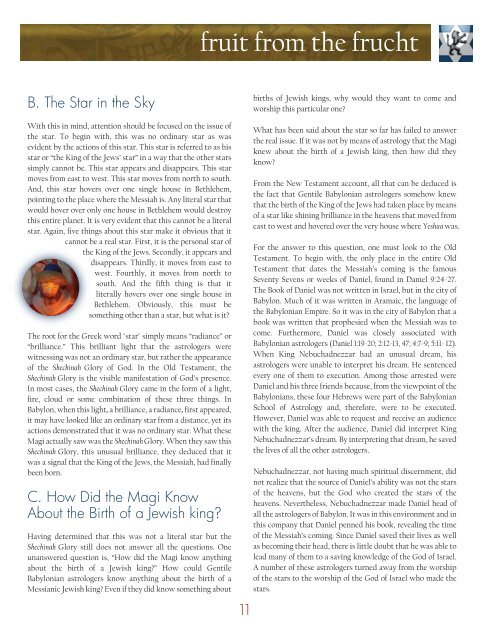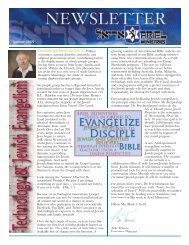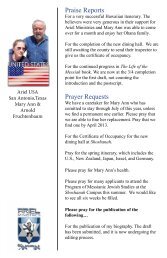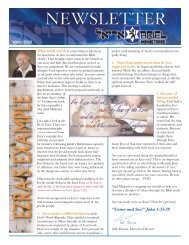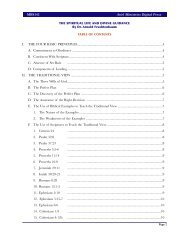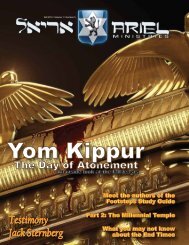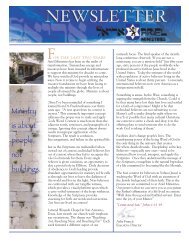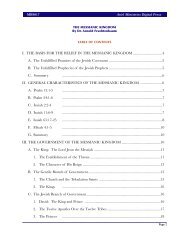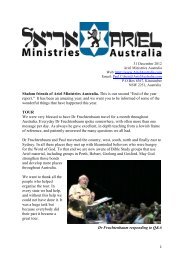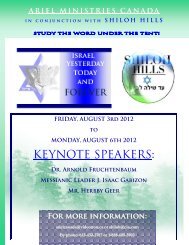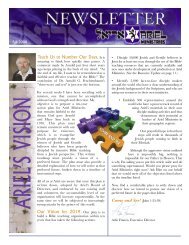My Hanukkah Story - Ariel Ministries
My Hanukkah Story - Ariel Ministries
My Hanukkah Story - Ariel Ministries
Create successful ePaper yourself
Turn your PDF publications into a flip-book with our unique Google optimized e-Paper software.
B. The Star in the Sky<br />
With this in mind, attention should be focused on the issue of<br />
the star. To begin with, this was no ordinary star as was<br />
evident by the actions of this star. This star is referred to as his<br />
star or “the King of the Jews’ star” in a way that the other stars<br />
simply cannot be. This star appears and disappears. This star<br />
moves from east to west. This star moves from north to south.<br />
And, this star hovers over one single house in Bethlehem,<br />
pointing to the place where the Messiah is. Any literal star that<br />
would hover over only one house in Bethlehem would destroy<br />
this entire planet. It is very evident that this cannot be a literal<br />
star. Again, five things about this star make it obvious that it<br />
cannot be a real star. First, it is the personal star of<br />
the King of the Jews. Secondly, it appears and<br />
disappears. Thirdly, it moves from east to<br />
west. Fourthly, it moves from north to<br />
south. And the fifth thing is that it<br />
literally hovers over one single house in<br />
Bethlehem. Obviously, this must be<br />
something other than a star, but what is it?<br />
The root for the Greek word "star" simply means “radiance” or<br />
“brilliance.” This brilliant light that the astrologers were<br />
witnessing was not an ordinary star, but rather the appearance<br />
of the Shechinah Glory of God. In the Old Testament, the<br />
Shechinah Glory is the visible manifestation of God’s presence.<br />
In most cases, the Shechinah Glory came in the form of a light,<br />
fire, cloud or some combination of these three things. In<br />
Babylon, when this light, a brilliance, a radiance, first appeared,<br />
it may have looked like an ordinary star from a distance, yet its<br />
actions demonstrated that it was no ordinary star. What these<br />
Magi actually saw was the Shechinah Glory. When they saw this<br />
Shechinah Glory, this unusual brilliance, they deduced that it<br />
was a signal that the King of the Jews, the Messiah, had finally<br />
been born.<br />
C. How Did the Magi Know<br />
About the Birth of a Jewish king?<br />
Having determined that this was not a literal star but the<br />
Shechinah Glory still does not answer all the questions. One<br />
unanswered question is, “How did the Magi know anything<br />
about the birth of a Jewish king?” How could Gentile<br />
Babylonian astrologers know anything about the birth of a<br />
Messianic Jewish king? Even if they did know something about<br />
fruit from the frucht<br />
11<br />
births of Jewish kings, why would they want to come and<br />
worship this particular one?<br />
What has been said about the star so far has failed to answer<br />
the real issue. If it was not by means of astrology that the Magi<br />
knew about the birth of a Jewish king, then how did they<br />
know?<br />
From the New Testament account, all that can be deduced is<br />
the fact that Gentile Babylonian astrologers somehow knew<br />
that the birth of the King of the Jews had taken place by means<br />
of a star like shining brilliance in the heavens that moved from<br />
east to west and hovered over the very house where Yeshua was.<br />
For the answer to this question, one must look to the Old<br />
Testament. To begin with, the only place in the entire Old<br />
Testament that dates the Messiah’s coming is the famous<br />
Seventy Sevens or weeks of Daniel, found in Daniel 9:24-27.<br />
The Book of Daniel was not written in Israel, but in the city of<br />
Babylon. Much of it was written in Aramaic, the language of<br />
the Babylonian Empire. So it was in the city of Babylon that a<br />
book was written that prophesied when the Messiah was to<br />
come. Furthermore, Daniel was closely associated with<br />
Babylonian astrologers (Daniel 1:19-20; 2:12-13, 47; 4:7-9; 5:11- 12).<br />
When King Nebuchadnezzar had an unusual dream, his<br />
astrologers were unable to interpret his dream. He sentenced<br />
every one of them to execution. Among those arrested were<br />
Daniel and his three friends because, from the viewpoint of the<br />
Babylonians, these four Hebrews were part of the Babylonian<br />
School of Astrology and, therefore, were to be executed.<br />
However, Daniel was able to request and receive an audience<br />
with the king. After the audience, Daniel did interpret King<br />
Nebuchadnezzar’s dream. By interpreting that dream, he saved<br />
the lives of all the other astrologers.<br />
Nebuchadnezzar, not having much spiritual discernment, did<br />
not realize that the source of Daniel’s ability was not the stars<br />
of the heavens, but the God who created the stars of the<br />
heavens. Nevertheless, Nebuchadnezzar made Daniel head of<br />
all the astrologers of Babylon. It was in this environment and in<br />
this company that Daniel penned his book, revealing the time<br />
of the Messiah’s coming. Since Daniel saved their lives as well<br />
as becoming their head, there is little doubt that he was able to<br />
lead many of them to a saving knowledge of the God of Israel.<br />
A number of these astrologers turned away from the worship<br />
of the stars to the worship of the God of Israel who made the<br />
stars.


